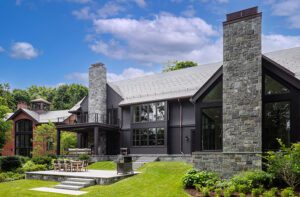Branching Out: Artist Leah Woods
March 17, 2014
Text by Lori Ferguson
New Hampshire artist Leah Woods, already acclaimed for her furniture making, is now using her medium to express more-abstract ideas.
Leah Woods has long been known for her exquisitely wrought, functional pieces. The sinuous lines of her cabinets, desks, and tables convey a captivating lightness and whimsy and reveal a great technical facility with wood.
Lately, though, the New Hampshire–based artist has thrown her design skill into giving concrete form to abstract ideas, trading physical functionality for a metaphorical functionality. For a recent series of works, Woods looked to women’s dress forms and undergarments for inspiration.
In Untitled #3: Dress Form in Mahogany, for example, a tight cylinder of red oak veneer is enlivened by thin incisions sweeping upward in graceful curves, much like the seams of the corset that inspired it. The piece is informed by historical context and imbued with conflicting emotions. Corsets were designed to enhance female beauty, but they did so by reshaping a woman’s form in unnatural, uncomfortable ways. The success of the work lies in its ability to suggest both sensuality and rigidity.
Woods first ventured into the arts as an undergraduate art history major at De Paul University, in Chicago. In her senior year, she enrolled in a 3-D design class and began working in steel, clay, and wood. “There was something about the materials and the three-dimensional nature of the work that I connected with,” she recalls.
Not long after graduating, Woods saw an ad for woodworking classes. Although she wasn’t sure why, the classes appealed, and before she knew it she had completed a series of basic woodworking courses and was on her way to earning a master’s degree in woodworking and furniture design at the Rochester Institute of Technology.
In retrospect, Woods believes she was set on her creative path by a passing remark from her 3-D design professor. “He said something to the effect that, ‘When making art, the best work uses materials that we all understand, but presents them in an unexpected way.’ I’ve never forgotten that,” she says.
While she felt the siren song of abstract forms for many years, Woods was initially reluctant and somewhat anxious about moving away from furniture making. “I’m formally trained in furniture design, and I didn’t want to disrespect my education,” she explains. But a 2009 residency at The Center for Art in Wood, in Philadelphia, gave her the confidence to change direction—indeed, it proved liberating. “Since letting go of the work’s functional component, I’ve been able to delve more deeply into the feelings and emotion I want to evoke. It’s challenging and it feels risky—I’m constantly asking myself, ‘How do I transform the idea in my head into a tangible piece of material, and when I do, will anyone understand what I’m trying to say?’”
Back and Forth, Woods’s first creation in her Navigation series of sculptural maps, is a compelling example of the new turn the artist’s work has taken. Strips of walnut and bleached mahogany seem to writhe with nervous energy, surging upward with an outbound sense of exploration in one area and, in another, turning in on themselves as though seeking safe harbor. Here is the excitement of discovery, tinged with the fear and uncertainty of the unknown, all expressed through the manipulation of line, plane, curve, and space.
The desire to coax the unexpected from the familiar drives Woods today, both as an artist and as a professor of woodworking and furniture design at the University of New Hampshire. In the classroom, she helps students achieve their creative vision through the application of real-world techniques. In the studio, Woods challenges herself to make objects that offer viewers an initial entry point via a familiar material, and then surprise them. “I love working in wood. It’s in our lives in many ways, so it offers me a way to attract people’s attention,” she explains. “Once I’ve got their eye, they begin to explore the subtleties of the piece, such as movement, form, or subject matter.
“When people encounter my work, I want them to sense emotion,” she says. “If someone sees a piece and experiences feelings of constraint or turmoil, for example, I’ve succeeded in making an emotional connection, and that’s immensely gratifying.”
Editor’s Note: To see more of Leah Woods’s work, visit her website, leahkwoods.com
Share
![NEH-Logo_Black[1] NEH-Logo_Black[1]](https://b2915716.smushcdn.com/2915716/wp-content/uploads/2022/08/NEH-Logo_Black1-300x162.jpg?lossy=1&strip=1&webp=1)















You must be logged in to post a comment.